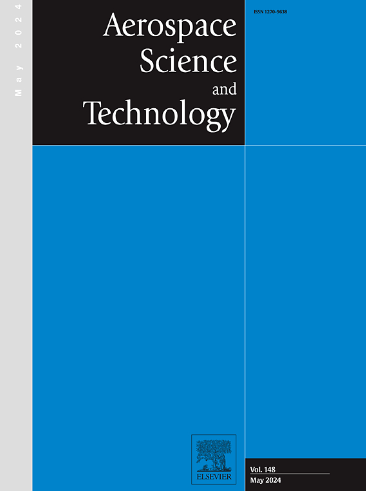Optimization flutter response of laminated smart nanocomposite truncated conical shell under supersonic aerodynamic pressure using hybrid IGWO-DQHFEM
IF 5
1区 工程技术
Q1 ENGINEERING, AEROSPACE
引用次数: 0
Abstract
Given the wide application of conical shells in the aerospace and aircraft industry, there comes a need for dynamic analysis and optimum design of these structures against supersonic aerodynamic forces, which induce a phenomenon called flutter. As the key contribution of this paper, a new method has been developed and applied to optimize the dynamic and flutter control of truncated conical shells under supersonic aerodynamic loads. Here, a truncated conical shell with a layered configuration is considered for the optimization of supersonic aerodynamic conditions with smart control, shape, and size optimum design, wherein every layer is reinforced with carbon nanotubes (CNTs). Moreover, a conical shell is considered with piezoelectric properties to smartly control the aerodynamic behavior of the structure, so by applying voltage, it will be possible to control flutter or critical aerodynamic pressure and frequency. The objective of the optimization model is defined based on aerodynamic pressure and frequency of conical shells. Mathematical modeling of the structure with high accuracy is carried out to optimize the model. The supersonic aerodynamic force is considered employing piston theory, where seven variables are used through a high-order shear deformation theory. In the new numerical method, the differential quadrature hierarchical finite element method (DQHFM) is used for the solution of the coupled electro- dynamic equations of the structure and computing the frequency of the structure along with the flutter or critical aerodynamic pressure. The optimization model obtained by the DQHFM method is applied to search the optimum conditions using an Improved Grey Wolf Optimization (IGWO) method. In IGWO, the local search condition is proposed based on the optimum positions and statistical properties of agents in previous positions. Finally, the optimum size, shape, and smart control parameters of the structure such as the length and radius of the cone, cone apex angle, external voltage, CNTs volume fraction, number of layers, and airflow angle are drawn out and discussed by IGWO and DQHFM. The results show that by increasing the cone angle from 30 o to 60 o, the optimum voltage that has to be applied decreases. On the other hand, an optimal radius stabilizes at around 1 m and the optimum volume fraction of the CNTs is 10 %.
应用IGWO-DQHFEM优化超声速气动压力下智能纳米复合材料截顶锥形壳的颤振响应
鉴于锥形壳体在航空航天工业中的广泛应用,有必要对这些结构进行动力分析和优化设计,以应对超音速气动力引起的颤振现象。作为本文的关键贡献,开发了一种新的方法,并将其应用于超声速气动载荷下截锥形壳体的动力和颤振控制优化。本文通过智能控制、形状和尺寸优化设计,研究了一种具有分层结构的截尾锥形壳体,其中每一层都用碳纳米管(CNTs)加固。此外,考虑到锥形壳具有压电特性,可以巧妙地控制结构的气动性能,因此通过施加电压,可以控制颤振或临界气动压力和频率。基于锥形壳的气动压力和频率,确定了优化模型的目标。对结构进行了高精度的数学建模,对模型进行了优化。超声速气动力采用活塞理论,其中七个变量通过高阶剪切变形理论来考虑。在新的数值计算方法中,采用微分正交分层有限元法(DQHFM)求解结构的耦合电动力方程,并计算结构的频率随颤振或临界气动压力的变化。将DQHFM方法得到的优化模型应用于改进的灰狼优化(IGWO)方法搜索最优条件。在IGWO中,基于agent的最优位置和前一位置的统计特性提出了局部搜索条件。最后,IGWO和DQHFM给出了该结构的最佳尺寸、形状和智能控制参数,如锥的长度和半径、锥顶角、外电压、CNTs体积分数、层数和气流角。结果表明,当锥角从30°增加到60°时,必须施加的最佳电压减小。另一方面,碳纳米管的最佳半径稳定在1m左右,碳纳米管的最佳体积分数为10%。
本文章由计算机程序翻译,如有差异,请以英文原文为准。
求助全文
约1分钟内获得全文
求助全文
来源期刊

Aerospace Science and Technology
工程技术-工程:宇航
CiteScore
10.30
自引率
28.60%
发文量
654
审稿时长
54 days
期刊介绍:
Aerospace Science and Technology publishes articles of outstanding scientific quality. Each article is reviewed by two referees. The journal welcomes papers from a wide range of countries. This journal publishes original papers, review articles and short communications related to all fields of aerospace research, fundamental and applied, potential applications of which are clearly related to:
• The design and the manufacture of aircraft, helicopters, missiles, launchers and satellites
• The control of their environment
• The study of various systems they are involved in, as supports or as targets.
Authors are invited to submit papers on new advances in the following topics to aerospace applications:
• Fluid dynamics
• Energetics and propulsion
• Materials and structures
• Flight mechanics
• Navigation, guidance and control
• Acoustics
• Optics
• Electromagnetism and radar
• Signal and image processing
• Information processing
• Data fusion
• Decision aid
• Human behaviour
• Robotics and intelligent systems
• Complex system engineering.
Etc.
 求助内容:
求助内容: 应助结果提醒方式:
应助结果提醒方式:


